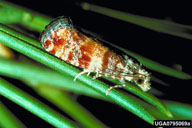|
There are three species of pine tip moths occurring in Georgia: the Nantucket pine tip moth, Ryacionia frustrana, the pitch pine tip moth, R. rigidana, and the subtropical pine tip moth, R. subtropica (Figure 86).
The Nantucket pine tip moth is the most widely distributed species and causes the most damage to recently planted pines. All native pines up to about 15 feet in height are attacked. Eastern white pine is considered resistant. Slash and longleaf pines may be infested under certain conditions but are generally considered resistant. Loblolly and shortleaf are the favored hosts. Severe and repeated attacks often result in stunted, bushy, and deformed trees (Figure 87).
The adult Nantucket pine tip moth is about 1/4" in length with irregular brick red and coppery patches on the forewings. The wingspan is about 1/2". The pitch pine moth range overlaps with the Nantucket pine tip moth and positive field identification is difficult. However, they have similar habits. The larvae of both species are small, yellowish to brownish and are approximately 1/8" in length.
Adult pine tip moths of the over wintering generation emerge in early spring. Depending on weather conditions, spring emergence may occur as early as January in South Georgia or as late as April in North Georgia. Egg laying begins soon after adult emergence. The temperature greatly influences the incubation period. After the larvae hatch they begin to feed on new shoots
|

Figure 86 - Adult Nantucket pine tip moth
photo by James A. Richmond |






